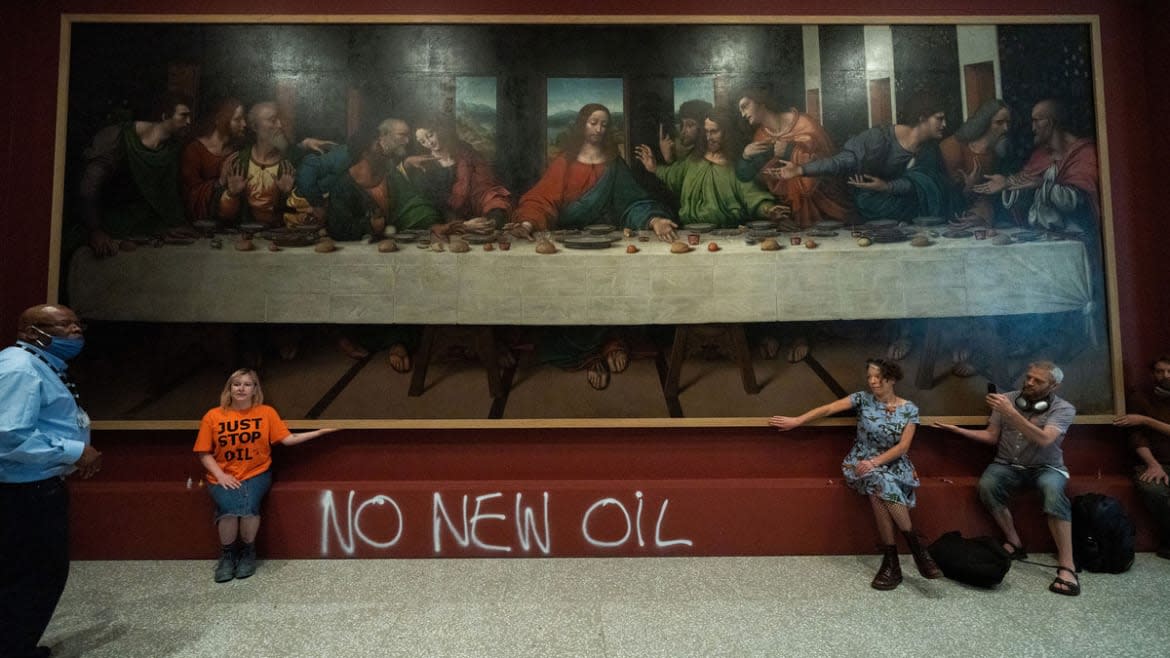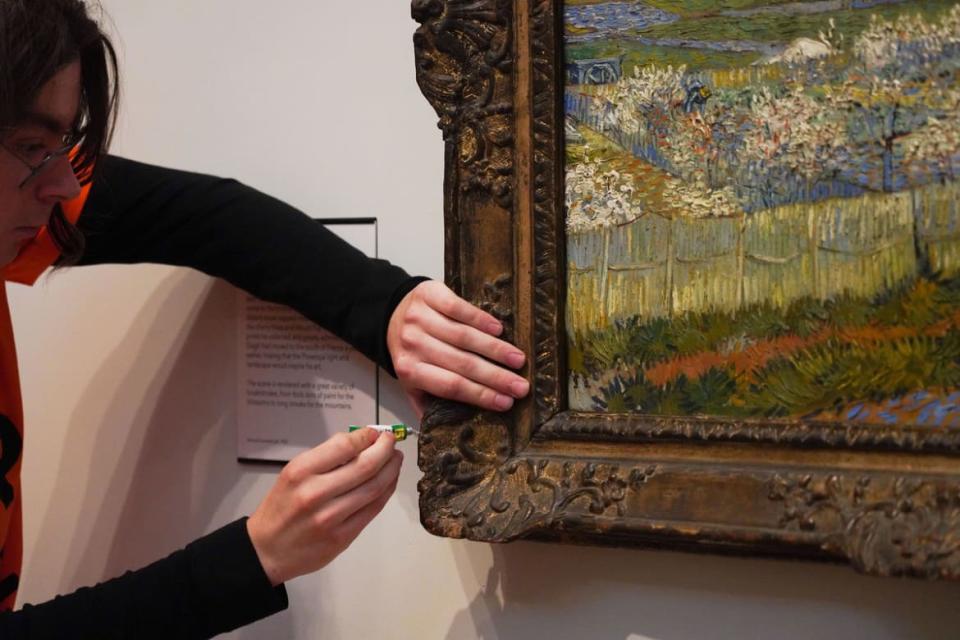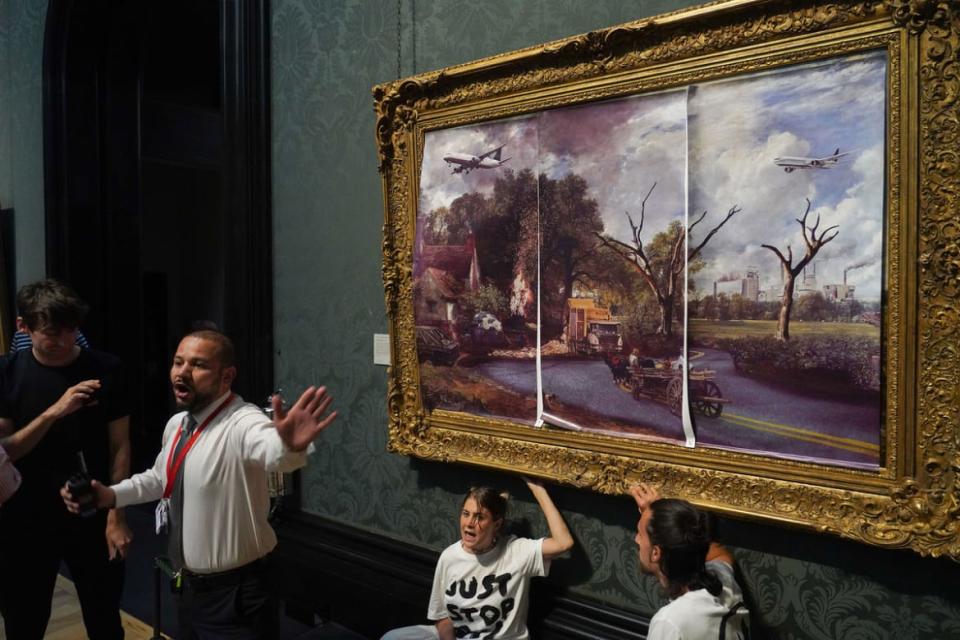The Activists Trying to Stick It to Big Oil by Gluing Themselves to Art

Across the U.K. over the past couple of weeks—at the Kelvingrove Art Gallery in Glasgow, the Manchester Art Gallery, and London’s Courtauld Gallery, Royal Academy of Arts, and National Gallery—demonstrators from the protest group Just Stop Oil have been gluing themselves to the frames of famous works of art.
This has caused rather a large fuss as shocked patrons and museum employees have taken in the spectacle, which is precisely the plan.
These protests are intended to grab the attention of leaders in the art world and to alert the public to the dangers of governments initiating new oil and gas projects as the climate crisis spirals. Thus far, the stunts are working: news outlets are breathlessly covering the protests, and footage of demonstrators stating their case has been shared widely on social media.
Protesters Storm Whitney Museum Over Vice Chairman’s ‘Tainted’ Money
“I’m taking action today because I can’t live in a bubble of normality when society is collapsing around us and people in the global south are suffering so much,” demonstrator Emily Brocklebank, who glued herself to the 1889 Vincent Van Gogh painting Peach Trees in Blossom at the Courtauld Gallery, said, according to Just Stop Oil. “Billionaires are getting richer whilst nurses queue at food banks, tens of millions of people across the world are starving and half the world’s population is exposed to extreme danger from heatwaves, floods, fires and famine.”
On July 4, another Just Stop Oil participant made a contentious appearance on British TV, getting into a heated debate with GMB co-anchor Ed Balls.
Some art workers have been extremely unamused by the protests: “I’m not interested,” a Manchester Art Gallery employee reportedly told one Just Stop Oil protester, who had glued himself to the 1809 JMW Turner painting Thomson’s Aeolian Harp, when he attempted to speak. “No. No. No. You’ve defaced our property… I don’t want to hear a word of what you’ve got to say. So please, give us some respect by just keeping quiet… Let this be a silent protest.” The Manchester Art Gallery did not respond to The Daily Beast’s request for comment.
Nevertheless, direct-action stunts in museums and galleries are proven to be effective methods of communication. Nan Goldin and her group P.A.I.N. (Prescription Addiction Intervention Now) have staged several disruptive protests within museums to call out the involvement of the opioid-peddling Sackler family in the art world, prompting many museums to remove the Sackler name from their walls.

Just Stop Oil climate activists glue themselves to a Van Gogh painting at the Courtauld Gallery, London, on June 30, 2022.
Similarly, protests at MoMA and the Whitney Museum of American Art in New York have been effective in pushing the institutions to change from within: after months of protests calling out his stake in the tear gas manufacturer Safariland, former Whitney vice chairman Warren B. Kanders stepped down from his role at the museum.
Simon Bramwell, a UK-based Just Stop Oil demonstrator, told The Daily Beast that he’d participated in gluing himself to a copy of Leonardo da Vinci’s The Last Supper attributed to Giovanni Antonio Boltraffio at The Royal Academy. “My experience of that—it was mixed,” Bramwell said. “It did hurt, but mainly because I glued myself on in a really stupid position.”
Bramwell is the cofounder of the global environmental movement Extinction Rebellion. He first mobilized with Just Stop Oil in April and has worked alongside many other activist organizations over the years. “I prefer doing things that are directly involved in helping to liberate, create and grow nature directly, and apart from that it’s that realm of direct action that also speaks to many different parts of the human experience, like the art actions,” Bramwell said.
The plan for Just Stop Oil activists to glue themselves to paintings has long been in the cards, Bramwell explained, adding that group discussed a 2020 protest during which Black Lives Matter demonstrators ripped down a statue of slave trader Edward Colston in Bristol while in the idea-generating stage.

In the National Gallery, London, two Just Stop Oil activists covered John Constable’s The Hay Wain with their own nightmare version of the countryside before gluing themselves to the frame.
“From a very pragmatic perspective, glue is easy to get away with,” Bramwell explained. “It challenges, antagonizes and polarizes people, and it also rides a line between direct intervention with a painting and destruction of a painting. Trying to minimize the damage to our culture is what this is all about, ultimately: our culture is on the cusp of self-destruction.”
“If you can steer the conversation in culture, politics follows, and there’s nowhere better to do that than the art world,” Bramwell said. “It’s full of iconoclastic controversy, but also classical philosophy and thought, and it seemed absolutely an ideal area to bring to account, if you will, the art world itself.”
Bramwell said that Just Stop Oil has been receiving the responses they’d hoped for. “Attendees, they really really got it,” he said. “Once they realized we weren’t a threat, museum staffers relaxed and also engaged with us. One of the security guards sang ‘Ain’t No Mountain High Enough,’ which was incredible, and we met with one of the directors of the Royal Academy and we had a good conversation.”
“The painting… suffered minor damage to its frame and there was also some disruption to the surface of the varnish on the painting, both of which have now been successfully dealt with,” the National Gallery, the site of another Just Stop Oil protest, told The Daily Beast in a statement, but declined to comment further. At the National Gallery, protesters had glued themselves to John Constable’s 1821 painting The Hay Wain.
Bramwell said Just Stop Oil is communicating with British artists who are interested in participating in planned, upcoming protests, and that “the invite is open” for international groups interested in continuing the glue protests in the U.S.
“There’s a huge, urgent need to tell the truth of these times, and that we are all, to put it quite bluntly, fucked unless we change things quite rapidly,” Bramwell said.
Get the Daily Beast's biggest scoops and scandals delivered right to your inbox. Sign up now.
Stay informed and gain unlimited access to the Daily Beast's unmatched reporting. Subscribe now.

